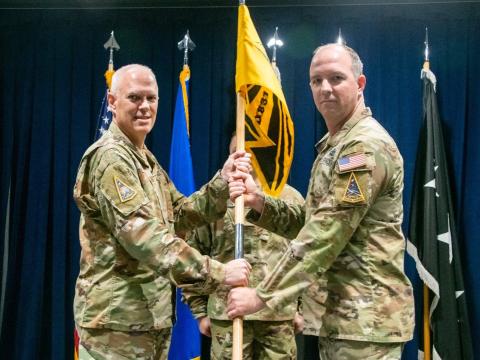Allied By Design
The U.S. Space Force is pursuing resilient space capabilities and disaggregated space architecture to support advanced missile warning and tracking systems, joint all-domain command and control, and space launch capabilities. With its Space Development Agency, it is setting the Proliferated Warfighter Space Architecture, or PWSA, through the proliferation of low-Earth orbit satellite constellations. In addition, the Space Force is pursuing resilient ground stations and terminals.
The service’s Fiscal Year 2025 budget request reflects the military’s shift away from expensive, exquisite systems and concentrated architecture, said Gen. Michael Guetlein, vice chief of Space Operations, U.S. Space Force.
“We have been really pursuing the resiliency of our space architecture, our space assets and our space capabilities in many different lanes,” said Gen. Guetlein, speaking at the 2024 Intelligence & National Security Summit.
“One of those lanes is through disaggregation. One of those lanes is through proliferation. One of those lanes is through disaggregation through partnerships, some partnerships with industry and partnerships with our allies. And the investments that you see in the budget today are really doubling down on that vision.”
And although the United States leads in space today, the People’s Republic of China is not far behind.
“They have not only become very content on denying our ability to use space, but they have become very capable at it as well,” Gen. Guetlein said. “That right there should be enough of an alarm. But it is even worse than that. They have proven that they are willing to operate in a very unsafe and unprofessional manner.”
Moreover, the U.S. economy depends on space operations, Gen. Guetlein continued. If an adversary were to disrupt systems, the impacts would be enormous, and quickly.
“It is not all about the military threat,” the general stated. “It really is about the threat to our way of life. If GPS was down for 15 minutes, it would be a billion-and-a-half dollar hit to our economy, every 15 minutes. Think about how major that impact would be to our economy. It would dwarf the impacts that we saw from COVID.”
And someday, adversaries may even be able to conduct large-scale assaults on what the U.S. is building now as part of its disaggregated space systems, the general said.
The power of alliances with other nations will be hard to beat, however, and it is something that the service and the Department of Defense (DoD) are leveraging in more meaningful ways than even just a few years ago, said the second-in-charge at the Space Force.
In many ways, the Space Force is working to be “allied by design.”
“We are having the same kind of partnerships in the development of the systems of our allies, where we really trying to get ‘allied by design,’” Gen. Guetlein emphasized. “Every capability that we design, we are trying to design the relationships and the interfaces in with our partnerships up front.”
For example, the Space Force is collaborating on deep space radars located in Australia and in the United Kingdom. “And we were talking about optical sensors down in Chile, and on satellite communications with Luxembourg,” the Space Force leader said.
One of the most exciting partnerships, according to Gen. Guetlein, is the Joint Commercial Operations (JCO) effort that brings U.S. allies and commercial partners together into the joint space operations floor at Schriever Space Force Base, Colorado. The service also has key operational floors in the United Kingdom and in New Zealand, set up as a “follow-the-sun mode,” synchronizing operations with the daily solar illumination to capture information from space.
“We have 15 different countries operating around our operational floor,” the general offered. “We are sharing the data left and right.”
It is not all about the military threat. It really is about the threat to our way of life. If GPS was down for 15 minutes, it would be a billion-and-a-half dollar hit to our economy, every 15 minutes.
The Space Force built an extensive repository of space domain awareness data from its operations and shares this so-called “data lake” with the international partners. “We take all of our unclassified space domain awareness data and we put it in this data lake, and we share it with all our international partners, and then they take their unclassified data and put it the data lake, which is shared with the other national partners.” And while the allied data lake is just for unclassified data, “obviously, we want to get to greater than unclassified data,” the general acknowledged.
The service, the DoD and the U.S. government will continue to work through some policy and statutory challenges regarding security and classification issues.
“We are committed to reducing the classification of our data to allow greater sharing of the data, and that is happening every single day,” Gen. Guetlein shared. “The good news is, everything that we're doing for the unclassified data is directly transportable to the way we do it at the higher classifications.”
With the Office of the Secretary of Defense (OSD), the Space Force is developing an Allied Space Strategy that will build on DoD’s existing Commercial Space Strategy and help guide the international relationships, especially at the operational level. “Where we are still struggling is the allies want to know what kit they should go build, what would help us the most as allies together,” the general explained. “There are many instances where we just can't tell them that answer. We are working on it in collaboration with OSD.”
Lastly, the Space Force in June added a leader from the United Kingdom to its top staff, with the hiring of Air Vice Marshal Paul “Godders” Godfrey. The British three-star general is now the assistant chief for Space Operations for Future Concepts and Partnerships at the U.S. Space Force for Chief of Space Force Operations Gen. Chance Saltzman. “He is a strategic advisor to Gen. Saltzman,” Gen. Guetlein explained. “He is one of our staff as an exchange officer. So that's hugely, hugely exciting.”
While the strength of the United States’ space alliance grows, the Space Force will continue daily to defend and protect space operations.
“It means we are there to guarantee the capabilities that we rely on for our way of life, we rely on for the joint fight and we rely on for our allies during times of crisis or conflict,” Gen. Guetlein said. “We must guarantee that we have access to the domain, access to space. It means that we need to be able to control behavior that is in space, and then we need to be able to create to our advantage, to guarantee our way of life.”
Allies On Staff





Comments